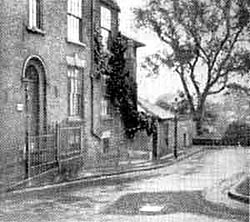< Previous | Contents | Next >
Standard Hill
 |
THE events leading up to the war between King Charles and the Parliament are far more complicated than are usually admitted.
The rowdy baronage of mediaeval England was exterminated during the Wars of the Roses. At the conclusion of that dreadful time the nation found itself tired of war but completely without leaders and without political experience. It gladly submitted to the strong and almost autocratic rule of Henry VII., and under him, and his immediate successors, it not only recovered from its wounds, but it learned its lesson of political expression, throwing up to the surface capable man after capable man.
Gradually the leading-string of Tudor rule became more and more galling to the nation, and in Elizabeth’s time it was only the intense personal loyalty to its beloved Queen "Gloriana" that kept the nation from taking the bit into its teeth.
By Elizabeth’s death this curb was removed.
James I. was a Scot—a foreigner—and since the Armada the nation was suspicious of all foreigners. He was determined to out-Tudor the Tudors in the absoluteness of his rule, and he believed implicitly in the Divine Right of Kings. The nation was equally determined to limit the royal power, and stood solid and foursquare against the King’s pretensions.
The only possible line of cleavage in the nation was along the line of religion. Since the Reformation, first the Roman Catholic Church had become unpopular, and then the pendulum had swung to the other extreme with the result that Puritanism was losing favour and an attempt to return to something nearer to the ancient faith was manifesting itself. These differences were so worked up by James that whereas when he came to the throne he found himself confronted by a solid and united nation, when he died he left a nation hopelessly divided by religious differences, the most bitter of all divisions.
Charles I. was a man of blameless character, but he was not the type of statesman to deal with such a situation as had been bequeathed by his father. His devotion to the reformed Church and particularly to its ritual was anathema to the Puritans, who suspected him of catholicism. Gradually the breach widened.
Everybody knows the story of Archbishop Laud, of the Irish Rebellion and of the Ship Money. These were but symptoms of the deeper disease.
War between the parties was inevitable, and it was commenced at Nottingham on 22 August, 1642, by Charles erecting his standard on the spot in the picture marked by an inscribed stone in the centre of the roadway near the Castle and ever afterwards known as Standard Hill.
